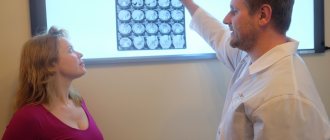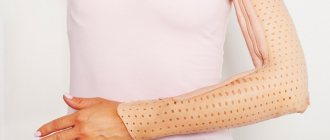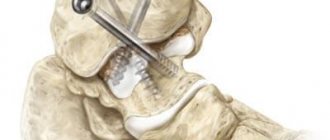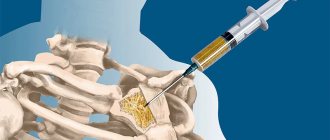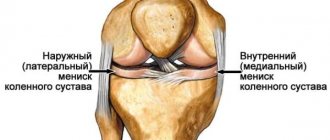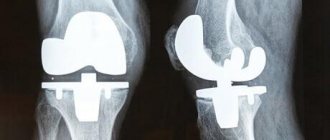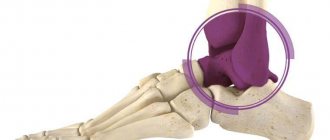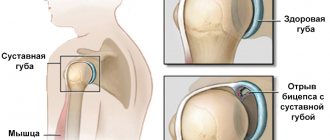Forceful correction of a deformity or congenital defect in the knee area is called knee retraining. This is one of the methods of articular correction, based on straightening the contracture of the articular joint. It is carried out manually or using special devices. The purpose of this procedure is to restore the functionality of the joint.
The essence of joint redress
The basis of manual actions is stretching tissue fibers or compressing them to restore the relative position of the main elements of the joint. The procedure is carried out once or in stages, depending on the speed of restoration of tissue plasticity. The correction effect obtained as a result of the first session is secured with a bandage. Over the course of several days, tissue fibers relax, the elasticity of the ligamentous apparatus and even the plasticity of the bone increases. With subsequent treatment sessions for contractures of both the shoulder and knee joints, improvement is achieved, expressed in the ability to flex or extend the limb. If the deformity is old and cannot be fully corrected, then after gradual redressation a less traumatic surgical intervention is chosen.
In childhood, redressing, due to better tissue extensibility, has a greater effect than in adults. Therefore, if the contracture is congenital, then treatment should be started immediately.
There are 2 types of procedures:
After applying the manual technique, a cast can be applied to the problematic joint.
- Manual. Only manual therapy is performed without the use of additional means. At the end of the session, a plaster cast may be applied.
- Instrumental. It is carried out using devices and devices, such as rubber traction, Schultz board, Lorenz apparatus. A more severe method and its use is limited due to the fact that with a strong impact on the articular apparatus, inflammation develops.
Redressing
Redressation is the forced correction of deformation or malposition of the musculoskeletal system, mainly the limbs. Redressation is one of the methods of orthopedic treatment. Redressation is based on tissue stretching or compression to restore the axis or configuration of a given area of the body.
Indications for redressing are connective tissue ankylosis, improperly healing fractures with axis curvature, contractures, congenital clubfoot, arthrogryposis, muscular torticollis and other types of deformities. Redressing is used more often in pediatric practice, since children's tissues are more elastic and pliable. Redressation is carried out with measured force, taking into account the elastic resistance of the tissues, without exceeding the limits of their strength, under or without anesthesia, depending on the type of deformation and the age of the patient.
There are two types of redressing - manual and instrumental (using various devices and redressing devices). Instrumental redressal is cruder and currently has limited application. Manual redressal is less traumatic, more accessible, and in some cases (congenital clubfoot, muscular torticollis, etc.) can be performed by nursing staff.
During manual redressing, the hands firmly grasp the upper and lower located parts of the limb and, using them as a lever, make careful short but quite strong pushes or stretching and compression in the direction opposite to the curvature for about 3-5 minutes. The tissues are stretched under the influence of these forces, and some correction of the vicious position is achieved. To maintain the achieved result, a fixing plaster bandage is applied for 1-2 weeks, depending on the type of deformity and the age of the patient. If it was not possible to completely eliminate the deformation at once, then after removing the plaster cast, redressing is carried out again and a plaster cast is applied again. Stage-by-stage redressal is repeated until the vicious situation is completely eliminated. The number of sessions depends on the type and degree of deformation. Insufficiently complete stretching of the tissues and non-compliance with the timing of fixation with a plaster cast can lead to relapse.
During redressing and after applying a fixing plaster cast, it is necessary to monitor the condition of the tissues, paying special attention to blood circulation. Bluishness, swelling, and loss of sensitivity require changing the bandage and reducing the amount of correction. Rough attempts at immediate re-dressing are dangerous, especially under anesthesia. They can lead to damage to large vessels and nerves, rupture of ligaments or muscles, and bone fractures.
Redressation (from the French redresser - straighten) is a violent, bloodless operation, without violating the integrity of the skin, correcting deformities, vicious positions, pathological settings of the limbs and other parts of the musculoskeletal system.
During redressing, tissues are forcibly formed through mechanical action: stretching of soft tissues on the concave, shortened side and compression on the convex, elongated side. The force of influence during redressing is commensurate with the degree of tissue elasticity. The elasticity of tissues prevents changes in the shape of the redressed organ, but as soon as it is overcome and the distance between the molecules of the body has exceeded the so-called radius of molecular influence, the given position and modification are preserved to one degree or another even after the cessation of force.
Further violence can lead to disruption of molecular cohesion, leading to tissue rupture. In such cases they talk about forced redressal. Modeling is called redressing, in which only the elastic limit is exceeded, but not the limit of tissue strength. Recession is indicated for contractures of various etiologies, for connective tissue ankylosis, bone curvature after diseases and as a result of fusion of unreduced fragments (at the stage of primary callus). In childhood, it is possible to correct even old curvatures, but to do this, you first have to resort to artificial softening of the bones (with the help of medications). Most often, redressation is used in the treatment of congenital clubfoot, torticollis, arthrosis, scoliosis, with deformities resulting from paralysis (spastic and flaccid), with rachitic curvatures, etc. Redressation can be both an independent and an auxiliary treatment method, preceding or complementing bloody operations (for example , during muscle transplants, during lengthening of the Achilles tendon, etc.). When performing one-stage redressing with inexperienced hands, complications are possible: damage to blood vessels, nerves (overstretching, ruptures), leading to circulatory and trophic disorders. Extensive interstitial hematomas, soft tissue ruptures, and bone fractures may occur. An outbreak of infection is possible as a result of gross violence in the joint area, which previously had an inflammatory process. Tissue swelling caused by severe redressing can cause compression of the limb with a plaster cast, which is usually applied after redressing. Less commonly, such complications are observed when fixing redressed tissues with a soft bandage or splint. If excessive compression, expressed by pallor or cyanosis of the distal limbs and loss of tactile sensitivity, is not promptly eliminated, gangrene may occur. In order to prevent injuries from excessive force (especially with increased tissue rigidity), they often resort to gradual correction of the deformity - in several stages (2-4-6 or more sessions) - staged redressation.
Devices for redressing: 1 - wedge; 2 - boards with a hinge; 3 - Thomas lever.
Redressing technique . The operator tightly grasps the patient's body with his hands distal and proximal to the deformity; then, using the lower part, like a lever, it makes jerking movements in the direction opposite to the curvature, and holds the limb (or other part of the body) in the corrected position for some time. Then he lets her go. The described manipulations are repeated several times, then the limb is secured in its given position with a bandage for a period of 2 to 6-8 weeks. With staged redressing, the fixation time and, accordingly, the breaks between sessions are 5-10 days. The bandage does not need to be completely removed; this allows you to save dressing material and, most importantly, prevent the loss of the correction achieved at the previous stage; It is enough to circularly cut the old plaster cast at the level of the curvature and cut out a wedge throughout the entire thickness of the sleeve on its long side. After the next redressing, the bandage is closed, forcefully bringing its edges together, and strengthened with several rounds of fresh plaster bandage.
To facilitate redressing, various devices are used, designed on the principle of a lever or screw (large and small Koenig wedges, Turner redressers, Schulze table, Thomas lever, boards with hinges, etc.) (Fig. 1-3). Retraining in children works well simply manually with a little muscle relaxation.
Redressation should be performed under anesthesia, after the usual preoperative preparation of the patient. Sometimes it is possible to successfully perform redressal under local anesthesia, including intraosseous anesthesia.
Indications and contraindications
Redressation is carried out for contractures of the knee, ankle, shoulder and elbow joints of the following etiology:
- desmogenic - changes in ligaments, connective tissue;
- myogenic - pathological processes in muscles;
- arthrogenic - hypertrophy of the joint capsule;
- neurogenic - damage to nerve endings.
In addition, changes in joint mobility may be congenital or associated with a previous disease:
Clubfoot can affect the development of joint pathology.
- clubfoot - a deformation of the foot in which it is deviated inward relative to the longitudinal axis of the lower leg;
- torticollis - an inclined position of the head with its rotation in the opposite direction;
- arthrogryposis is a systemic disease of the musculoskeletal system, characterized by changes in the limbs, underdevelopment of joints and muscles, as well as proliferation of connective tissue;
- infantile paralysis;
- polio;
- rheumatism.
Absolute contraindications:
- active inflammatory process of specific or nonspecific origin in the area of redressal;
- significant osteoporosis;
- fixed contractures.
How is it carried out?
The technique for redressing bone joints differs depending on the location:
You can return normal motor activity to the foot by performing pushing movements with it.
- Knee: If there is local restriction of the extension movements of the knee joint, the patient is placed with his back on the operating or massage table. The physician performing the procedure places a hand on the back of the person's lower leg and the other on the front of the knee and pushes to straighten the leg.
- When flexion movements are limited, the patient is placed on his back, the doctor grabs the lower leg with both hands and moves it like a lever, pushing the lower limb at the knee joint.
After achieving a positive effect, interrupt the procedure for 2 minutes. Then the same techniques are repeated. With each movement, the amplitude of the redressing force increases. During manipulation, sometimes the adhesions are broken. During the procedure, doctors monitor proper blood circulation and the condition of nerve fibers. After redressing, the limb is often fixed with a plaster cast. Rehabilitation after removal of the plaster cast includes massage, exercises and thermal treatments for the deformed limb.
Rehabilitation
The recovery period depends on the severity of the deformity that was corrected. It can be carried out after the plaster cast is removed and the result is fully consolidated. Rehabilitation with physical exercises should be prescribed by a doctor. To begin with, general developmental exercises for the hand are performed. They need to be done every day for a week. After the period has expired, you can slightly increase the load on the limb. The hand should gradually get used to exercises of varying difficulty. In the first days there are unpleasant sensations, but if you do everything correctly and carefully, they will pass in a few days. They also prescribe developmental massage and thermal waters.
Possible consequences
When redressing joints, the possibility of negative disorders, such as:
During the procedure, the patient may experience reflex convulsions.
- recurrence of stiffness;
- fractures of small bones;
- overstretching or rupture of ligaments;
- stretching of the great vessels and nerves;
- reflex spasms;
- thrombosis;
- circulatory disorders.
To avoid these dangerous consequences, it is necessary to carefully and carefully carry out the entire redressing procedure, constantly take into account the degree of tissue tension, fix in plaster casts only those tissues in which elastic forces are completely suppressed, without assigning additional corrective functions to the bandage. Before the procedure, the doctor collects anamnesis and determines indications and contraindications for manipulation.


